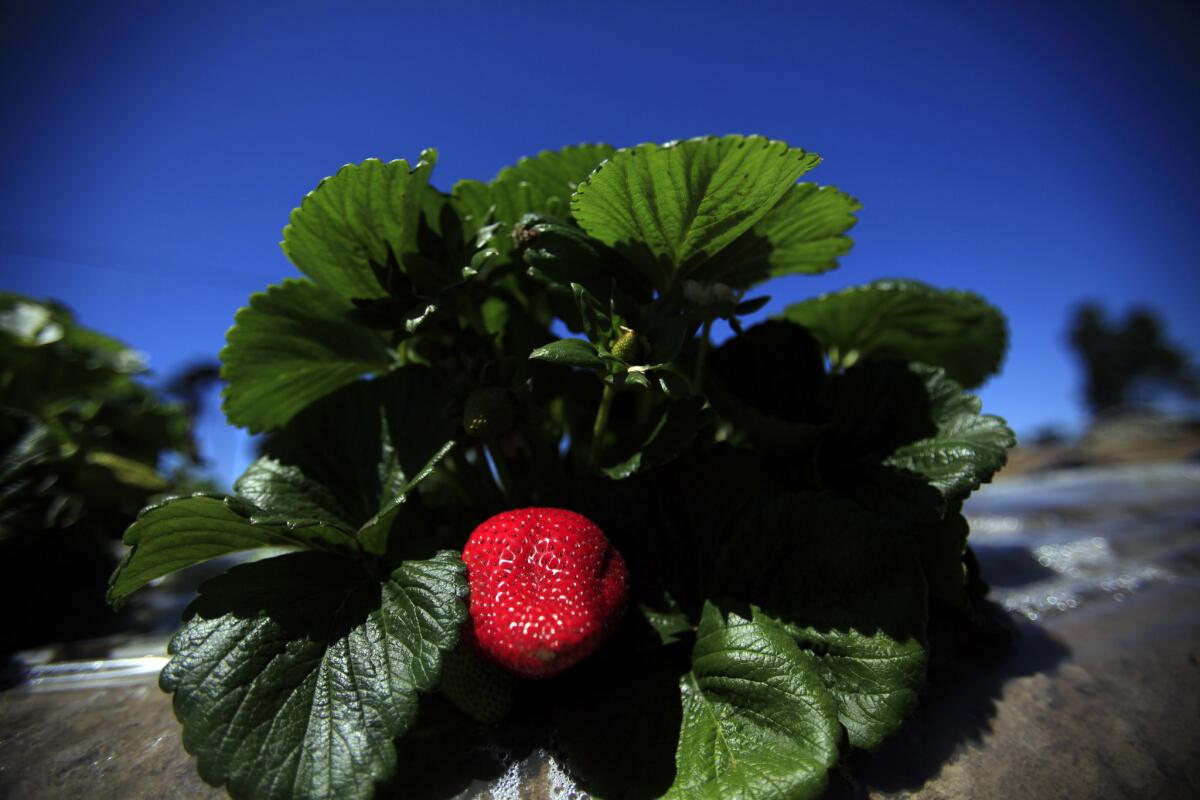California tightens rules on popular pesticide — and carcinogen — Telone

- Share via
California will tighten rules on how much farmers can use the common pesticide Telone, listed by the nation’s most productive agricultural state as a chemical known to cause cancer, regulators said Thursday.
The change doesn’t ban Telone but creates a uniform rule for its application each year. The rule is drawing criticism from farmers who call it a key way to fight pests and fear the crackdown could lead to higher food prices.
The U.S. Environmental Protection Agency does not limit annual use of Telone, and California is the only state to restrict how much can be applied, said Charlotte Fadipe, spokeswoman for the state Department of Pesticide Regulation.
Growers inject Telone into the soil to kill pests before planting new orchards, vineyards and crops, such as sweet potatoes, carrots and strawberries.
It dissipates before crops are planted, and officials say harmful residue isn’t found in food. Rather, the fumes released when it is first applied potentially can cause health issues when people breathe it in over long periods of time.
Brian Leahy, director of the pesticide regulation department, announced the new rule, which he said protects public health while allowing farmers to keep an important tool to kill pests. It goes into effect Jan. 1.
“I believe that overhauling the way we manage the pesticide, to be based upon a fixed amount, will be health-protective and simpler to manage,” Leahy said in a statement.
Now, farmers are allowed to use 90,250 pounds of the chemical each year within 6 square miles. They can carry over unused amounts from one year to the next — potentially doubling the base allowance. Until recently, they also could request a waiver from the state to use more than double the limit in a year, officials said.
The new rule limits the annual allowance to 136,000 pounds with no option for carrying over unused amounts. Farmers also will not be permitted to use the chemical in December, when California’s weather conditions make the air concentrations of the pesticide higher, officials said.
Merced sweet potato farmer Bob Weimer criticized the stricter regulation, saying that Telone is an essential way to kill pests in California, which grows nearly half of the nation’s fruits, nuts and vegetables.
“It’s going to have an impact on consumers,” Weimer said. “There’s no question about it.”
Farmers like Weimer already are limited in ways to kill pests, he said, adding that the change doesn’t make sense because his fields are miles from the nearest community.
Telone came under fire recently when the Oakland-based Center for Environmental Health sued its maker, Dow Agro-Sciences. The health advocacy group contends that Dow fails to warn people in farming communities throughout California when Telone is being used, as required by law.
No direct cases of illness have been linked to Telone, but Caroline Cox, the center’s research director, says the state’s job is to protect residents in the face of grave consequences.
“We can’t wait for that particular kind of information,” she said. “It takes so long, and it’s so hard to get.”
Mark Weller, co-director of Californians for Pesticide Reform, said the agency bowed to the wishes of Dow and is trying to “spin” the new regulations as an improvement.
“It’s simply egregious that DPR has again ignored the voices of the front-line communities most at risk, who have repeatedly demanded better protections from this cancer-causing chemical,” Weller said.
Growers in California applied more than 13 million pounds of the chemical in 2014, the last year for which complete information was available, according to the California Department of Pesticide Regulation.
Most of it was applied in Fresno, Kern, Merced, Monterey and Tulare counties, on soil used to grow almonds, strawberries, sweet potatoes, grapes, carrots, peppers, tomatoes and other unspecified row crops, according to the department.
The California Department of Food and Agriculture suspended all Telone use in 1990 after air regulators in the Central Valley detected airborne levels of the chemical that were considered a health concern, according to the department.
After Dow devised new methods to apply the chemical, state regulators removed the suspension in 1995 but established the annual cap on its use.
Under pressure from county agricultural commissioners, however, the Department of Pesticide Regulation allowed growers to “bank” unused chemicals from a previous year, effectively doubling the cap.
In 11 townships, the department has allowed even more to be applied — as much as 230,000 pounds, according to Fadipe, the department’s spokeswoman. That practice ended two years ago, she added.
Times staff writer Geoffrey Mohan contributed to this report.
ALSO
Think you’re lactose intolerant? This dairy wants to prove you wrong
California proposes pesticide buffer zones around schools and day cares
Dow fails to warn Californians when pesticide Telone is used, lawsuit alleges
UPDATES:
1:35 p.m.: This article was updated with additional reporting.
This article was originally published at 6:55 a.m.
More to Read
Inside the business of entertainment
The Wide Shot brings you news, analysis and insights on everything from streaming wars to production — and what it all means for the future.
You may occasionally receive promotional content from the Los Angeles Times.










